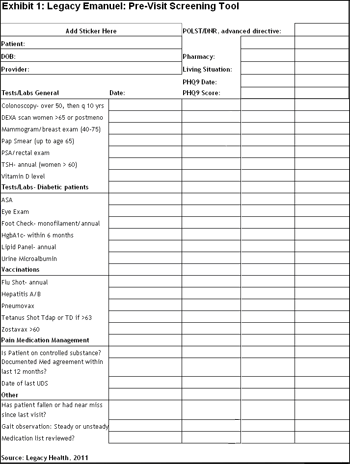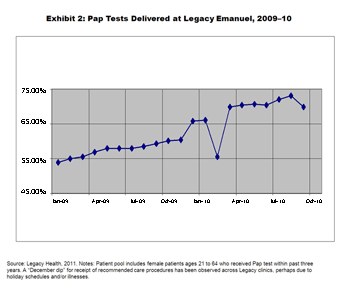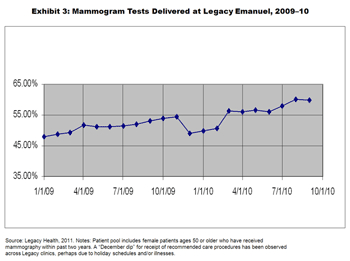Summary: The implementation of a patient-centered medical home model at Legacy Clinic Emanuel, a safety net primary care clinic in Portland, Oregon, illustrates some of the benefits of a team-based care. The clinic assigns patients to primary care teams, including physicians, nurses, and medical assistants, which rely on a separate support team to help handle administrative duties, referrals, and outreach tasks. Team members use chart reviews, daily huddles, care protocols, and performance feedback to ensure the delivery of appropriate care. The new model has resulted in increased access, greater productivity, and improved care.
By Martha Hostetter
Issue
Building interdisciplinary care teams—with greater roles for nurse practitioners, nurses, medical assistants, social workers, receptionists, and other support staff—is often viewed as a means of expanding the capacity of the primary care workforce.[1] Such care teams may help ensure that the millions of Americans who are extended coverage under the Affordable Care Act have access to high-quality care. The federal health reform law promotes team care through its support for medical homes, primary care extension centers, accountable care organizations, and other types of collaboration. Still, there are few practical models to follow.
Organization and Leadership
Legacy Clinic Emanuel is one of the safety net primary care clinics involved in the Safety Net Medical Home Initiative, a demonstration program supported in part by The Commonwealth Fund. The program provides technical assistance, training, and support to 65 community health centers that are transforming themselves into patient-centered medical homes.
Legacy Clinic Emanuel, located in Portland, Ore., is part of Legacy Health, a system that includes six hospitals, 17 primary care clinics, and a number of specialty practices in the Portland and Vancouver, Wash., area. Legacy Emanuel provides primary care to more than 14,000 patients a year, 30 percent of whom are covered by the Medicaid program. The remaining patients are covered by private insurance (35%), Medicare (25%), or are uninsured (10%). Patients are drawn from culturally diverse neighborhoods in northeast Portland, which include many low-income and homeless individuals. The clinic also serves as a teaching facility, drawing medical residents from area schools.
Jackie Ross is the project manager for Legacy Health's medical home initiative. Melinda Muller, M.D., is the health system's clinical vice president for primary care. Maryna Thompson, R.N., is Legacy Emanuel's clinic manager and Prasanna Krishnasamy, M.D., is one of its faculty physicians.
Process of Change
In 2007, Legacy Health launched a program to transform its 17 primary care clinics into medical homes that use a team-based model of care (an effort that predated Legacy Emanuel's involvement in the Safety Net Medical Home Initiative). Legacy Emanuel was the original pilot site for this project. Four other Legacy sites representing diverse practice types launched medical homes later that year: Legacy Good Samaritan, like Legacy Emanuel, is a safety net clinic; Legacy Northeast and Legacy Northwest both serve mostly privately insured patients; and Legacy St. Helens is a rural health care facility. As of April 2011, 10 of Legacy Health's clinics had adopted the medical home model. The remaining seven will implement it by September 2011.
Initial funding for the pilot program came from CareOregon, the local Medicaid managed care organization, which encouraged Portland-area health care professionals to adopt a model of care instituted by Alaska's Southcentral Foundation that emphasizes team-based care, proactive panel management, patient-centered care, advanced access, and behavioral health integration.[2]
During the second year of the pilots (2008), the local Blue Cross Blue Shield plan provided additional funding to support the transition to medical homes. By December 2010, CareOregon and Blue Cross Blue Shield funding had been discontinued, but the workforce changes at the clinics had become partially self-supporting due to additional revenue from increased productivity and pay-for-performance incentives (see Results).
The initial funding enabled Legacy Emanuel to hire a social worker and a team assistant to perform clerical duties such as faxing, filing, and chart review. The clinic then formed three primary care teams. One team includes three medical assistants, two registered nurses, and five physicians—all of whom are faculty members. The other two primary care teams each include 13 medical residents and a registered nurse. Those two teams share four medical assistants among them.
All of the primary care providers are assisted by a support team, which includes a clinical pharmacist, referral coordinator, social worker, community outreach specialist, and team assistant. By offloading many administrative and care coordination duties to the support team, clinicians have more time to focus on patient care. They also have help with common challenges such as making timely referrals to specialists and tracking down unresponsive patients. All care team members provide mutual support and redundancies to ensure that appropriate steps are taken. "By spreading out the work, fewer things fall through the cracks because there are more eyes paying attention," says Muller. "The patients then get the care they need, which should help avoid complications in the future."
Legacy Emanuel's patients are assigned to one of the three primary care teams, enabling clinicians to build relationships with patients and provide more continuous care. The social workers from the support teams tend to have frequent contact with patients and encourage them to seek out help when needed. Medical assistants and nurses who anchor the core primary care teams help compensate for the fact that medical residents spend a limited amount of time at the clinic.
Legacy Emanuel used Plan-Do-Study-Act (PDSA) cycles and Lean methodology to launch the care teams and study and improve workflow. For example, it followed a PDSA cycle to increase screening rates for diabetes and depression, common conditions among their patients. The PDSA approach was used to develop care protocols for diabetes, pain management, and other conditions—enabling nurses and medical assistants to order tests, draw lab work, and follow other prescribed steps without having to check with physicians each time. Front office staff, medical assistants, and nurses also administer diabetes and depression screening instruments before visits and notify clinical staff and resource specialists if the results indicate problems.
Before each visit, primary care teams use a screening tool that summarizes preventive care and chronic care treatments that have been completed and acts as a "tickler" to prompt orders for needed follow-up care (Exhibit 1). The goal of team care is to treat the "whole person," says Ross, and to "do as much as you possibly can during the visit. Some of these patients don't have working phones, so we can't contact them, and some don't have homes where we can send reminders." The primary care teams also have daily "huddles," or short meetings at the beginning or end of each day to review procedures and prepare for the next group of patients. 
Legacy Emanuel collects a large amount of data on care processes, access to care, emergency department visits and hospitalizations among their patients, and outcomes (see Results). These reports are regularly discussed by the care teams and presented at monthly clinic managers' meetings.
Results
Increased Productivity, Reduced Costs to Payers
Team care has enabled Legacy Emanuel to increase productivity and earn enough additional revenue to offset the costs of the two additional staff members. In 2008 and 2009, it had 10 percent more patient visits—including new patients as well as increased numbers of visits from existing patients—than before adopting team care. It has also earned additional revenue by increasing the provision of recommended laboratory tests and immunizations.
In addition, the team care model has saved money for Medicaid and other payers by reducing the number of emergency department visits and hospitalizations. During 2008 and 2009 across Legacy Health's five original medical home pilot sites, including Legacy Emanuel, there were 2,273 fewer emergency department visits, $2.1 million less in emergency department charges,125 fewer inpatient stays, and $3.1 million less in hospital charges. These decreases compare with system-wide increases of 8 percent in emergency department charges and 2 percent in hospital charges during the same time period. (Data are not available on the decreased acute care charges among Legacy Emanuel patients only.)
For Legacy Health's uninsured and Medicaid patients, the reduction in acute and emergency care means that the health system has reduced its burden of unreimbursed care. For other patients, fewer hospitalizations and complications do mean lost revenue, however. "The senior leadership of Legacy believes in the concept [of medical homes] and the way health care reform is moving so much that they are willing to tolerate this to position us for the future," Muller says.
Improved Care
Legacy Emanuel is participating in a pay-for-performance program with CareOregon. Clinics receive additional funds for meeting or exceeding benchmark levels, or for increasing their performance by three percentage points or more, on process-of-care measures (e.g., mammography testing, depression screening, tobacco screening), outcomes (e.g., diabetes and hypertension control), and indicators of access to and continuity of care (e.g., number of days until next-available appointment, the percent of appointments that take place with members of patients' designated care teams). As a result of improved performance on such measures, Legacy Emanuel began earning additional Medicaid payments in 2010 and has thus far received $77,000.
 For example, Legacy Emanuel has provided more patients with timely recommended care such as Pap tests and mammograms (Exhibits 2 and 3). Team care also seems to have enabled Legacy clinicians to keep better track of their patients and follow up with those whose chronic conditions are not under control. Thus far, the clinic has documented improvements in outcomes for diabetes patients, for whom care protocols were adopted in 2010 (Exhibit 4).
For example, Legacy Emanuel has provided more patients with timely recommended care such as Pap tests and mammograms (Exhibits 2 and 3). Team care also seems to have enabled Legacy clinicians to keep better track of their patients and follow up with those whose chronic conditions are not under control. Thus far, the clinic has documented improvements in outcomes for diabetes patients, for whom care protocols were adopted in 2010 (Exhibit 4).

In addition, clinical staff now use a more rigorous process for following up with patients after hospitalizations or emergency department visits. Calls to such patients among all five of the pilot sites had increased by 30 percent by the end of 2010.
Patient, Staff, and Provider Satisfaction
Based on a survey fielded from October through December 2010, patients appear to be satisfied with the care they receive at Legacy Emanuel. They report having relatively good access to care, though there is room for improvement. Seventy-five percent of patients said they were able to be seen for immediate care when needed, 64 percent said they were able to make timely appointments for routine care, and 58 percent said they had been seen within 15 minutes of their scheduled visit time. Most respondents said that their doctors listen to them carefully (90%), give understandable instructions (88%), have knowledge of their medical history (88%), show respect for them (94%), and spend enough time with them during visits (82%). And fully 94 percent of patients said they would recommend the practice to others. (Comparable data prior to the implementation of team care are not available.)
Legacy Emanuel's clinicians and support staff have noted several improvements associated with team care and the broader medical home model. At a January 2011 focus group that included the clinic manager, medical assistants, administrative staff, a behavioral health provider, a pharmacist, and a registered nurse, participants pointed to the following benefits: being able to proactively identify patients that need chronic care management; using the screening tool to anticipate patients' needs; having regular communication among team members; using a workflow team; and enabling patients to build relationships with their providers.
Lessons and Implications
The patient-centered medical home model, with team-based care at its heart, can increase productivity at primary care practices and expand access to care.
Legacy Emanuel has been able to expand access to high-quality care by relying on multidisciplinary teams and support staff to treat greater numbers of patients and deliver more recommended care. It has also benefited from having its reporting requirements to a major payer—Medicaid—aligned with incentives to improve through a pay-for-performance program. This model of collaboration shows that Medicaid can play an important role in promoting team care models that improve the quality and efficiency of care.
There also appears to be a business case for health care purchasers to encourage team care. Since Legacy Health clinics have adopted care teams that seek to proactively manage patients' care and avoid complications, CareOregon and other payers have avoided significant acute care costs.
Team-based care has the potential to improve care processes and outcomes.
Now in its fourth year of working as a team, Legacy Emanuel's primary care staff have systems for monitoring patient care, proactively managing chronic conditions, and keeping each other informed—resulting in increased delivery of recommended care and some improvement in health outcomes.
Legacy Emanuel has been able to cultivate strong care teams in spite of its challenges as a safety net provider—with many hard-to-reach and complex patients—and its status as a teaching facility with frequent turnover among medical residents who are themselves still learning how to provide basic care.
"You need to get everyone in the same room together regularly to understand the issues and work on problems from many vantage points," says Muller. "Each team member has a slightly different perspective on what's going on and how to solve it. Unless you have each of those voices represented at the table, you won't create a solution that works for everyone. "
Muller also notes the importance of capturing data on the effects of changes in real time to demonstrate the effectiveness of team care and facilitate targeted improvement efforts. "It doesn't have to be perfect but has to be good enough to be trusted," she says. Legacy Health is in the process of implementing the Epic electronic medical record system across its 17 clinics. Once this system is in place, it will be easier for staff to track different patient populations and identify gaps in care.
Team members should be given opportunities to work to their full potential.
Legacy Emanuel has succeeded in part by encouraging its core clinical staff—medical assistants and nurses—to stretch their skills and pursue new opportunities. For example, medical assistants now do much more than greet patients and take their blood pressure; they have been involved in spreading the team model to other clinics and are being trained to act as health coaches. Nurses, too, have embraced new roles as care managers. The hope is that giving staff challenging roles and opportunities for growth will improve their work life and thus increase retention.
"Moving to team care is not a top-down approach," says Ross. "We definitely need front office and medical assistant staff to buy in. If they make changes, it makes it easier for providers and makes the benefits more visible to patients."
For team care to succeed, patients need to be educated about the model and consulted on how well it is working for them.
Legacy Emanuel fields quarterly patient satisfaction surveys and plans to hold a focus group to elicit further feedback from patients. It is also creating informational materials to educate patients about the team care model. "Our staff are really good at explaining who they are, what role they play on the team, and giving out their cards so that patients know who to contact in various situations," says Ross. Team care has resulted in reduced call volume at Legacy Emanuel (and at all of the other medical home sites), indicating that patients know which providers to call for their particular needs and are more often able to reach them on the first attempt.
There is a need for practical guidance about how to form care teams and training to develop the competencies needed to work on them.
Legacy Health will roll out the medical home model to its seven remaining primary care clinics later this year. Based on the lessons learned, the health system's leaders plan to provide more detailed explanations of team members' roles at the outset and standardize the change process. Specifically, within one month clinics will be required to have biweekly team meetings to discuss the changes and a workflow team to focus on implementing team care. Clinicians will also have to use the screening tool and hold team huddles.
Legacy Emanuel team members also suggest that teamwork could be promoted through the creation of internships to partner new employees with senior staff, and through communication among different health clinic teams to discuss best practices.
For further information, contact: Jackie Ross, project manager, medical home, Legacy Health, at [email protected].
Notes
1. See for example: K. G. Shojania, S. R. Ranji, K. M. McDonald et al., Effects of Quality Improvement Strategies for Type 2 Diabetes on Glycemic Control: A Meta-Regression Analysis, Journal of the American Medical Association, December 13, 2006 296:427–40.
2. S. Klein and D. McCarthy, CareOregon: Transforming the Role of a Medicaid Health Plan from Payer to Partner, The Commonwealth Fund, July 2010.
